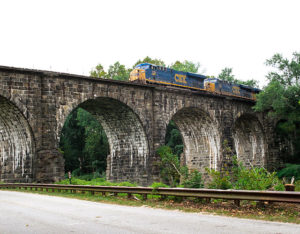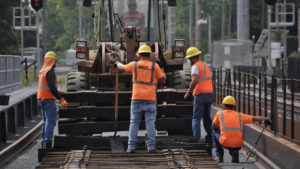Sierra Northern railroad purchase advancing
Written by jroodSierra Northern Railway Engine No. 48 rumbles slowly down the tacks toward Watsonville, Calif. A growling, 125-ton rolling box of steel and fuel, its form or one similar has hauled people and goods along the 32 miles of the Santa Cruz Branch Line railroad since 1881. Beneath it, the tracks and the land at least 20 feet on either side are owned by Union Pacific, as old and imposing a company as you'll find in American business. And until the Cemex cement plant in Davenport closed down in January, Cliff Walters and Wes Swift, the engineer and conductor inside the train, had plenty of work driving loads both north and south of Santa Cruz, their bosses at Sierra making a modest but steady profit while turning over lease payments in cash and services to UP like clockwork.
These days, business is
slow, revenues are down and, as most residents have heard by now, the
state-funded Santa Cruz County Regional Transportation Commission is ready to
spend $19.2 million to buy the rail corridor ($14.2 million for the tracks and
property, plus $5 million in repairs), Metro Santa Cruz reports. The purchase
would boot UP from its landlord role and give taxpayers their very own
railroad. It could also furnish the county with a "rail trail"
bicycle route running parallel to the tracks-although that would cost anywhere
from $32 million to $100 million over and above the rail line purchase price.
Supporters of the rail trail, however, are enthusiastically on board with the purchase,
considering it the first step toward their goal.
For county residents, the
sweet, gooey center of the deal is that their risk is almost nonexistent. The
money for the acquisition comes from two California state transportation funds
set aside for just such a purpose. Plus, Sierra Northern would cover the
estimated $350,000 in annual maintenance costs to keep the tracks in working
order.
The RTC expects to pay
about $170,000 per year to manage the property, but says revenues from leases,
property easements and train car storage will combine to cover most of the
cost. Whatever expenses remain the RTC will cover, leaving the cash-strapped
county government out of the equation.
For RTC executive
director George Dondero, and indeed for the vast majority of county leaders and
residents in the know, the rail purchase is a rare slam-dunk deal.
"This is a one-time
opportunity," Dondero says. "Owning the Branch Line will offer
transportation options to future generations they wouldn’t have otherwise."
The RTC has to act soon,
though. More than half the price tag-$10.2 million-will come from state bond
sales stemming from 1990’s rail transportation initiative, Prop. 116. It being
20 years since voters passed the measure, however, the fund is on the verge of
expiration, and unless the RTC commits to acquiring the railroad before June
30, the money could be reassigned to another railroad-hungry county. (The other
$9 million comes from the State Transportation Improvement Program fund and has
fewer restrictions and no looming deadline.) This "use it or lose it"
scenario has created a sense of urgency that defies the last 10 years of
endless negotiations and political posturing over this same deal.
Now, besides the spirited
endorsement of the RTC, the rail purchase enjoys support from the Santa Cruz
County Board of Supervisors and the county’s Metropolitan Transit District, as
well as the Watsonville, Capitola and Santa Cruz city councils and cycling and
environmental groups countywide
But what will Santa Cruz
County residents do with a railroad line? For the foreseeable future: not much.
Back on board Engine 48,
Walters and Swift, two sturdy-looking men with more than 50 years of railroad
experience between them, keep the speed in check and the intersections clear.
The thought of a publicly owned railroad appeals to them. "It’ll clean up
the tracks, put some more interest in the railway," says Walters, his eyes
fixed on the tracks and his hand on the air brake lever.
The rail workers’ support
doesn’t come lightly. Under the contract drawn up by the RTC, Sierra Northern
absorbs the bulk of the deal’s risk, as it would be responsible for paying
track maintenance costs while gambling that freight business will increase and
a tourist-shlepping "dinner train" from Capitola to Davenport will
succeed.
Should the business plan
fail, the company could pull out of the county, leaving the tracks to rust and
the RTC with 32 miles of property that used to make money. Even then, however,
the RTC could use an age-old option called "railbanking" that would
allow it to put off maintenance but maintain ownership until a new train
operator is found.
Sierra president Dave
Magaw says he’s well aware of the risk, but promises his company is "in it
for the long haul."
Not everyone is on board
with the rail purchase. A group of Aptos residents, most with property lines
that abut the rail corridor, is calling itself the Santa Cruz Coalition Against
Recreational Rail and represents perhaps the most vocal opponents of the
purchase. Critics accuse it of classic NIMBYism, but fiscal conservatives as
well as supporters of widening Highway 1 are standing up to the proposal as
well. Martin Bryant, a Santa Cruz resident who lives on Morrissey Boulevard,
several blocks from the tracks, says the purchase is just one more example of
"government spending gone wild."
"This is just more
money being poured down a rat hole," says Bryant. "I believe in
widening Highway 1 because it’s a capital project. We’re putting the cart way
before the horse here and we need to step back and re-evaluate."
Members of the county’s
Metropolitan Transit District are also worried. Though the board officially
endorsed the purchase on April 23, the vote was not unanimous, and it came with
the stipulation that the RTC promise that no funding would be siphoned from the
county bus system’s $7.5 million tax-subsidized budget. MTD member and Scotts
Valley Vice Mayor Dene Bustichi voted against supporting the acquisition, and
as an RTC member, he says he’s changed his mind "at least a dozen
times."
"The RTC is
anticipating that we are going to be getting funds from passenger rail and
renting [train car] storage space," he says. "One, those funds have
yet to materialize. And two, even if there are funds available, we don’t know
how much there will be. … We’re buying a rail line that doesn’t operate
efficiently and doesn’t have enough activity to keep it going. We may have the
money to purchase it, but do we have the money to maintain it?"
Bustichi’s concerns,
however, have more to do with the financial well-being of the RTC than of Santa
Cruz County residents. As owners of the rail corridor, the RTC would have
several crisis-averting options if business tanks. And even if Sierra leaves,
the tracks fall apart and a bevy of unanticipated costs arise, the losses would
be borne by the state taxpayer-supported RTC, not the local county government.
Whoever ends up with the
Santa Cruz Branch Line, most supporters and opponents of the purchase agree
that its current use as a minor freight route and a major pedestrian highway
for county drunks is a waste of resources.
Whether a local agenda
will revitalize the tracks into a legitimate transportation corridor or not,
Santa Cruz County residents will likely have decades to decide for themselves.
"I say let the people
own it," Swift says on the bumpy 12-mile-per-hour train ride back from
Watsonville. "If not now, we could lose it forever."





